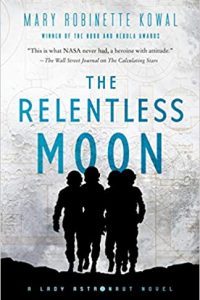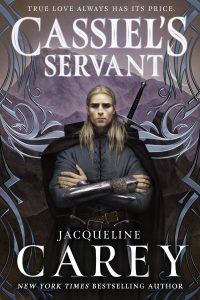Maya C. James Reviews Honeycomb by Joanne M. Harris
 Honeycomb, Joanne M. Harris (Saga 978-1-534-43305-8, 28.00, 432pp, hc) May 2021. Cover by Charles Vess.
Honeycomb, Joanne M. Harris (Saga 978-1-534-43305-8, 28.00, 432pp, hc) May 2021. Cover by Charles Vess.
Like most remarkable stories, Honeycomb begins with a dream.
But in this universe of sadistic kings, wounded creatures, and wise honeybees, even a dream is more elusive than one might think. In “Nectar”, the origin story of Honeycomb, the Dream is a river that runs through the Nine Worlds, reflecting the hearts and desires of the Folk. On its shore, a nameless flower’s pollen gives birth to the powerful Honeycomb Queen, and becomes the first story of the Nine Worlds. According to the bees – the collective choir and inter-world travelers who tell us these tales – stories have the power to communicate across worlds.
Joanne M. Harris’s Honeycomb drips with whimsy, mischief, and violent delight. Over the course of this dark, adult fantasy novel/collection (it’s truly a hybrid of the two), Harris offers us an astoundingly wide array of parables and tales that cover themes of power, love, empathy, self-sacrifice, and truth. Similar to her 2016 novel The Gospel of Loki, Harris imbues new meaning into various fairy tales without abandoning their sinister origins. From the cruel exploits of the selfish Lacewing King to the realpolitik of stubborn barnyard animals, she magicks a collection of dark fairy tales steeped in European tradition. Her strongest tales are those that remain within this cultural frame of reference, while those outside of it are weakened by exoticized descriptions of isolated religious desert societies. Charles Vess’s distinctive illustrations appear throughout the novel, enhancing the ancient, folklore-like feeling Harris evokes in each story.
A common thread that interweaves these seemingly unrelated stories is the selfish ruler of the Silken folk: the Lacewing King, who is raised without consequences and empathy. Split into two books, Book One (“Long Ago”) follows the early years of the Lacewing King and the characters impacted by his horrid selfishness. However, after a particularly fierce encounter, the indulgent lifestyle of the Lacewing King gives way to a journey of self-discovery, sacrifice, and redemption in Book Two (“Far Away”). His adventures occasionally intersect with the tales of other minor characters, and opposing antagonists who seek revenge against him for his past wrong doings. While he is a magnetic character, in the sense that we’re consistently drawn to him, many stories independent of his character are just as fine of stories as others that depend on his antics.
There were quite a few chapters, so it was inevitable that some short stories emerged as favorites. I was both amused and horrified by the actions of the barnyard animals in “The Wolves and the Dogs”. Similar reactions were provoked from the occasional, voyeuristic looks into the mediocre villagers who only whispered of the Silken Folk, as in “The Girl Who Loved the Silken Folk”. The builder of boats character arc was incredibly touching, and offered a wonderful blend of redemption and revenge in a collection fraught with disturbing cruelty (“Return of the Harlequin” is an especially moving example of this). The stories that focused on turbulent relationships and love across the Nine Worlds were the most touching and memorable (see “Moonlight” and “The Mermaids in the Mirror” as two examples of this). “The Moon Queen of the Undersea and the Moon King of the Sky” was among the strongest stories for both its imagery and its depictions of love and lust. Unfortunately, “The Scarlet Slippers” was an awkward read for its simplistic, Orientalist depiction of faith and fundamentalism. It had one of the most unexpected endings, however, so my feelings towards this particular story were mixed.
Readers familiar with Joanne Harris may also be aware that she is exceedingly gifted at producing vivid imagery. Expect indulgent descriptions of Silken Folk palaces and the Nine Worlds throughout the novel. I found myself returning to passages to simply bask in the beautiful prose – the fairytale format truly allowed her to lean into this lavish prose.
While it is evident that Harris is well versed in these traditions, the simplistic format of a fairy tale can be surprisingly tricky – staying true to the original story without sacrificing its original message can be an exercise in restraint and outdated mores – but her characters have flaws as real as the Nine Worlds they inhabit, and relationships as turbulent as the Lacewing King’s enemies. Harris knows how to craft characters that bend reader’s expectations, despite the seemingly predictable cadence of traditional European fairy tales. Among these recurring characters, the Lacewing King, Spider Queen, Builder of the Boats, Barefoot Princess, and the Harlequin were among my favorites.
Another way that Harris managed to subvert fairytale expectations was by allowing stories the room to breathe and constrict as needed; some stories were no longer than two pages, and others sprawled across the novel. With the increase in novellas and micro fiction over the past few years, the use of flexible story lengths was a clever choice. No story draws out longer than it needs to. Some stories are no longer than two pages, but still rich in indulgent descriptions and nameless characters who are just as memorable as other named characters.
On the subject of length – this is a long book. I doubt one would want to read it all in one sitting, regardless of how enticing each story may be. Harris ends stories decisively enough that readers can continue reading all the way through or pick the book back up later.
Honeycomb is an extraordinarily solid collection, expected considering Harris’s strong writing chops across genres and years of dedication to this standalone novel. She is well versed in various European fairytale and folklore, including the Grimm Brothers. At a certain point, the cadence of the fairytale format can feel tedious, but the stories are imbued with so much volatility and macabre that Honeycomb is neither a gory retelling of Grimm Brothers, nor is it a survey of European folklore. It is an enchanted, character-driven collection-novel hybrid filled with wonder. Some stories are mere standalone tales of otherwise ordinary villagers experiencing the Fae. Others, expansive allegories that reflect the politics of today.
Maya C. James is a graduate of the Lannan Fellows Program at Georgetown University, and full-time student at Harvard Divinity School. Her work has appeared in Star*Line, Strange Horizons, FIYAH, Soar: For Harriet, and Georgetown University’s Berkley Center Blog, among others. She was recently long listed for the Stockholm Writers Festival First Pages Prize (2019), and featured on a feminist speculative poetry panel at the 2019 CD Wright Women Writer’s Conference. Her work focuses primarily on Afrofuturism, and imagining sustainable futures for at-risk communities. You can find more of her work here, and follow her on Twitter: @mayawritesgood.
This review and more like it in the March 2021 issue of Locus.
 While you are here, please take a moment to support Locus with a one-time or recurring donation. We rely on reader donations to keep the magazine and site going, and would like to keep the site paywall free, but WE NEED YOUR FINANCIAL SUPPORT to continue quality coverage of the science fiction and fantasy field.
While you are here, please take a moment to support Locus with a one-time or recurring donation. We rely on reader donations to keep the magazine and site going, and would like to keep the site paywall free, but WE NEED YOUR FINANCIAL SUPPORT to continue quality coverage of the science fiction and fantasy field.
©Locus Magazine. Copyrighted material may not be republished without permission of LSFF.





